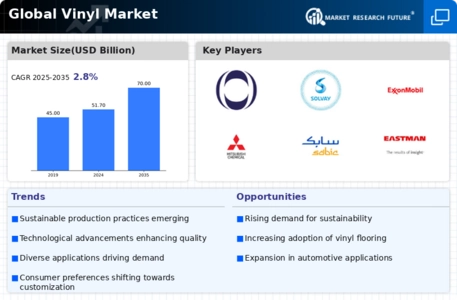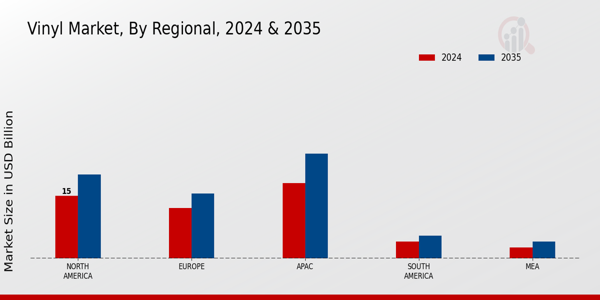Market Trends and Projections
The Global Global Vinyl Market Industry is characterized by various trends and projections that indicate its future trajectory. As of 2024, the market value is estimated at 51.7 USD Billion, with expectations to reach 70 USD Billion by 2035. This growth is underpinned by a projected CAGR of 2.8% from 2025 to 2035, reflecting a steady increase in demand across multiple sectors. Factors such as technological advancements, sustainability initiatives, and the expansion of applications in construction and consumer goods are likely to drive this growth. The market's resilience and adaptability suggest a promising outlook for stakeholders.
Growth in Construction Activities
The Global Global Vinyl Market Industry is significantly influenced by the expansion of construction activities worldwide. As urbanization accelerates, the demand for building materials, including vinyl, is on the rise. Vinyl's versatility and cost-effectiveness make it an attractive option for various construction applications, such as windows, doors, and roofing. In regions like Asia-Pacific, rapid infrastructure development is further propelling this demand. The market is projected to reach 70 USD Billion by 2035, reflecting a robust growth trajectory. This growth is likely to be supported by government initiatives aimed at enhancing infrastructure, thereby boosting the consumption of vinyl products.
Rising Demand for Sustainable Materials
The Global Global Vinyl Market Industry is witnessing a notable shift towards sustainable materials, driven by increasing environmental awareness among consumers and manufacturers. Vinyl, known for its recyclability and durability, is becoming a preferred choice in various applications, including construction and automotive sectors. For instance, the construction industry is increasingly utilizing vinyl for flooring and siding due to its long lifespan and low maintenance requirements. This trend is expected to contribute to the market's growth, with projections indicating a market value of 51.7 USD Billion in 2024. As sustainability becomes a priority, the demand for eco-friendly vinyl products is likely to rise.
Expanding Applications in Consumer Goods
The Global Global Vinyl Market Industry is benefiting from the expanding applications of vinyl in consumer goods. Vinyl is increasingly being used in products such as packaging, flooring, and home furnishings due to its versatility and cost-effectiveness. The rise in disposable income and changing consumer preferences are driving the demand for vinyl-based products. For instance, the packaging industry is adopting vinyl for its lightweight and durable properties, which enhance product protection. This trend is likely to contribute to the market's growth, as consumers increasingly seek durable and aesthetically pleasing options. The overall market is expected to reflect a positive trajectory in the coming years.
Technological Advancements in Vinyl Production
Technological advancements in the production of vinyl are playing a crucial role in shaping the Global Global Vinyl Market Industry. Innovations in manufacturing processes have led to improved product quality, reduced production costs, and enhanced efficiency. For example, the introduction of advanced extrusion techniques allows for the creation of high-performance vinyl products that meet stringent industry standards. These advancements not only cater to the growing demand for high-quality vinyl but also contribute to the overall market growth, with a projected CAGR of 2.8% from 2025 to 2035. As technology continues to evolve, it is likely to further enhance the competitiveness of vinyl in various applications.
Increasing Use of Vinyl in Automotive Applications
The Global Global Vinyl Market Industry is experiencing a surge in the use of vinyl in automotive applications, driven by the need for lightweight and durable materials. Vinyl is increasingly being utilized in vehicle interiors, exteriors, and components due to its aesthetic appeal and functional benefits. The automotive sector's shift towards more sustainable materials aligns with the growing consumer preference for eco-friendly vehicles. This trend is expected to bolster the market, as manufacturers seek to incorporate vinyl into their designs. The anticipated growth in automotive production and the rising demand for vinyl components may significantly impact the overall market dynamics.
























